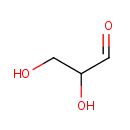| Synonyms: | - α,β-dihydroxypropionaldehyde
- (+/-)-2,3-dihydroxy-Propanal
- (+/-)-Glyceraldehyde
- 2, 3-Dihydroxy-Propanal
- 2,3-Dihydroxy-Propionaldehyde
- 2,3-Dihydroxypropanal
- 2,3-Dihydroxypropionaldehyde
- A,b-Dihydroxypropionaldehyde
- Alpha,beta-Dihydroxypropionaldehyde
- D-(+)-Glyceraldehyde
- D-2,3-Dihydroxypropanal
- D-2,3-Dihydroxypropionaldehyde
- D-Aldotriose
- D-Glycerose
- Delta-(+)-Glyceraldehyde
- Delta-2,3-dihydroxypropanal
- Delta-2,3-dihydroxypropionaldehyde
- Delta-aldotriose
- Delta-Glyceraldehyde
- Delta-glycerose
- Dihydroxypropionaldehyde
- DL-GLYC
- DL-Glyceraldehyde
- DL-Glyceric aldehyde
- DLG
- Glyceraldehyde
- Glyceric aldehyde
- Glycerinaldehyde
- Glycerinformal
- Glycerose
- α,β-Dihydroxypropionaldehyde
- δ-(+)-Glyceraldehyde
- δ-2,3-Dihydroxypropanal
- δ-2,3-Dihydroxypropionaldehyde
- δ-Aldotriose
- δ-Glyceraldehyde
- δ-Glycerose
|
|---|
| References: |
- Beard KM, Shangari N, Wu B, O'Brien PJ: Metabolism, not autoxidation, plays a role in alpha-oxoaldehyde- and reducing sugar-induced erythrocyte GSH depletion: relevance for diabetes mellitus. Mol Cell Biochem. 2003 Oct;252(1-2):331-8. Pubmed: 14577607
- Choei H, Sasaki N, Takeuchi M, Yoshida T, Ukai W, Yamagishi S, Kikuchi S, Saito T: Glyceraldehyde-derived advanced glycation end products in Alzheimer's disease. Acta Neuropathol (Berl). 2004 Sep;108(3):189-93. Epub 2004 Jun 17. Pubmed: 15221334
- Fujita T, Funako T, Hayashi H: 8-Hydroxydaidzein, an aldose reductase inhibitor from okara fermented with Aspergillus sp. HK-388. Biosci Biotechnol Biochem. 2004 Jul;68(7):1588-90. Pubmed: 15277768
- Gugliucci A: A practical method to study functional impairment of proteins by glycation and effects of inhibitors using current coagulation/fibrinolysis reagent kits. Clin Biochem. 2003 Mar;36(2):155-8. Pubmed: 12633766
- Haraguchi H, Hayashi R, Ishizu T, Yagi A: A flavone from Manilkara indica as a specific inhibitor against aldose reductase in vitro. Planta Med. 2003 Sep;69(9):853-5. Pubmed: 14598214
- Iwata H, Ukeda H, Maruyama T, Fujino T, Sawamura M: Effect of carbonyl compounds on red blood cells deformability. Biochem Biophys Res Commun. 2004 Aug 27;321(3):700-6. Pubmed: 15358163
- Jonas AJ, Lin SN, Conley SB, Schneider JA, Williams JC, Caprioli RC: Urine glyceraldehyde excretion is elevated in the renal Fanconi syndrome. Kidney Int. 1989 Jan;35(1):99-104. Pubmed: 2709665
- Kanehisa, M., Goto, S., Sato, Y., Furumichi, M., Tanabe, M. (2012). "KEGG for integration and interpretation of large-scale molecular data sets." Nucleic Acids Res 40:D109-D114. Pubmed: 22080510
- Keseler, I. M., Collado-Vides, J., Santos-Zavaleta, A., Peralta-Gil, M., Gama-Castro, S., Muniz-Rascado, L., Bonavides-Martinez, C., Paley, S., Krummenacker, M., Altman, T., Kaipa, P., Spaulding, A., Pacheco, J., Latendresse, M., Fulcher, C., Sarker, M., Shearer, A. G., Mackie, A., Paulsen, I., Gunsalus, R. P., Karp, P. D. (2011). "EcoCyc: a comprehensive database of Escherichia coli biology." Nucleic Acids Res 39:D583-D590. Pubmed: 21097882
- Nagaraj RH, Oya-Ito T, Padayatti PS, Kumar R, Mehta S, West K, Levison B, Sun J, Crabb JW, Padival AK: Enhancement of chaperone function of alpha-crystallin by methylglyoxal modification. Biochemistry. 2003 Sep 16;42(36):10746-55. Pubmed: 12962499
- Phillipou G, Seaborn CJ, Phillips PJ: Re-evaluation of the fructosamine reaction. Clin Chem. 1988 Aug;34(8):1561-4. Pubmed: 3402055
- Takeuchi M, Yamagishi S: Alternative routes for the formation of glyceraldehyde-derived AGEs (TAGE) in vivo. Med Hypotheses. 2004;63(3):453-5. Pubmed: 15288367
- Yamagishi S, Nakamura K, Inoue H, Kikuchi S, Takeuchi M: Serum or cerebrospinal fluid levels of glyceraldehyde-derived advanced glycation end products (AGEs) may be a promising biomarker for early detection of Alzheimer's disease. Med Hypotheses. 2005;64(6):1205-7. Pubmed: 15823718
- Zakrzewska I, Prokopowicz J, Worowski K, Skrzydlewska E, Puchalski Z, Piotrowski Z: Low molecular organic inactivators in differentiating organ origin of alpha-amylase in humans. Part I. Mater Med Pol. 1989 Oct-Dec;21(4):274-6. Pubmed: 2518736
|
|---|


